65 Degrees F
Sunny, Light N Wind
Bonjour! What a beautiful day in our jardin potager, there is a coolness to the air and a clear view across the recently harvested plains to the bluffs beyond. In this season of the Hunter’s Moon (the first full moon following the Harvest Moon), the trees are donning their fall palette of subdued golds and reds, spreading across the fields and forests, adding color to the valley. As always when I first arrive in the jardin, a moment is taken to observe and relish the moment, similar to unwrapping a package anxious to see what is hidden within. Walking in the jardin this day, I observe the new growth in our main beds, even though rain has been scarce. The snapdragons along with the leeks, lettuce, radishes, spinach, and turnips are thriving. 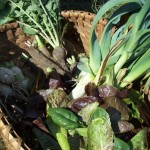 Vegetables are harvested quickly so beds can be weeded and deeply watered. The beds most recently planted with lettuce and spinach are just now sprouting and their new growth is breaking through the soil. I am much relieved that the lack of rain has only slowed these new plantings. Interestingly, the seed germination of earlier plantings of late August and early September had mixed success in the dry weather. The colors of the heirloom Merville de Quatre Saisons Cimmaron, and Forellenschluss lettuces are vibrant and strong with deep purples to bright greens and the leafy tops of the Spanish Black radishes and Navet des Vertus Marteau turnips look healthy and strong. The Golden and Crapaudine beets and some of the lettuces and carrots just could not get enough moisture to thrive in the simmering heat of this past late summer and early fall. Their growth is sporadic at best. As the carrots are watered, I accidently splash a visitor to our garden.
Vegetables are harvested quickly so beds can be weeded and deeply watered. The beds most recently planted with lettuce and spinach are just now sprouting and their new growth is breaking through the soil. I am much relieved that the lack of rain has only slowed these new plantings. Interestingly, the seed germination of earlier plantings of late August and early September had mixed success in the dry weather. The colors of the heirloom Merville de Quatre Saisons Cimmaron, and Forellenschluss lettuces are vibrant and strong with deep purples to bright greens and the leafy tops of the Spanish Black radishes and Navet des Vertus Marteau turnips look healthy and strong. The Golden and Crapaudine beets and some of the lettuces and carrots just could not get enough moisture to thrive in the simmering heat of this past late summer and early fall. Their growth is sporadic at best. As the carrots are watered, I accidently splash a visitor to our garden. 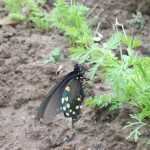 This Pipevine or Blue Swallowtail Butterfly has been making himself at home, feeding heavily among the St. Valery carrot tops. But his handsomeness makes it difficult to complain.
This Pipevine or Blue Swallowtail Butterfly has been making himself at home, feeding heavily among the St. Valery carrot tops. But his handsomeness makes it difficult to complain.
The last of the Black Beauty eggplants, Georgia Rattlesnake, and Missouri Heirloom melons are still ripening as we come to the close of their season. Next week will be the time to pull up the last of the remaining melon plants and turn over the unplanted beds, adding new organic matter to replenish the soil. The native garden and the melon beds in the fields beyond our main garden will be ready to be tilled with the last of the surviving Crenshaw melons soon to be being harvested. While making notes on the jardin’s successes and challenges of this past year, already thoughts are skittering along to next spring and the ever hopeful promise of a new season.
We were happy to meet new visitors to our jardin potager at the SIH Fete at the Fort earlier this month. This event was very successful and we doff our caps to the organizers for a job well done. Many first time visitors were impressed with our Fort and enjoyed the vendors and the music of L’Esprit Creole featuring Dennis Stroughmatt and Rob Krumm. This month, ongoing in the Illinois Country, visit the Haunted Creole House Experience, 7-11 p.m., Creole House, Prairie du Rocher. “A Tragedy Beneath the Bluffs.” $7. Sponsored by Randolph County Historical Society.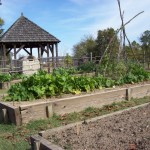 http://www.randolphcountyillinois.net. Halloween with a historic twist!
http://www.randolphcountyillinois.net. Halloween with a historic twist!
In the next journal entry, I have some recipes to share that feature the heirloom vegetables currently being harvested in our jardin potager of the Illinois Country. Enjoy the season of the Hunter’s Moon, the views and tastes it offers!
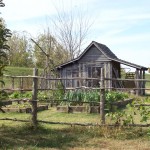
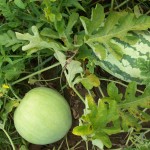
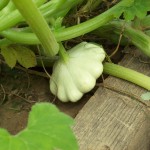
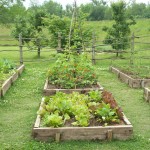
Recent Comments